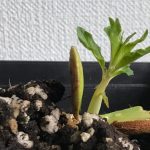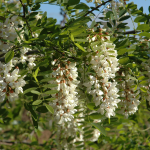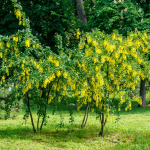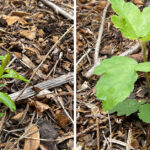Masting Cycle: A Pear Tree’s Journey and Ecosystem Impact

In the world of gardening and horticulture, we often stumble upon phenomena that leave us in awe, teaching us the intricate rhythms of nature. One such phenomenon is the masting cycle, also known as mast seeding, a natural event that has graced my garden with its presence, turning my pear tree into a focal point of learning and wonder.
The journey began nearly a decade ago, with the planting of two pear trees in a space reclaimed from a row of Sitka spruce. Over the years, one of these trees has taken us on a remarkable journey through its masting cycles, offering not just a bounty of delicious pears but also rich lessons on the rhythms of nature.
From the early days of modest yields averaging 2-3kg (4.4-6.6 lbs) to the staggering harvests of 13.5kg (nearly 30 lbs) and 14kg (over 30 lbs) in the masting years, the tree has been a generous giver. The masting cycle brought with it a delightful dilemma of abundance, leading to culinary adventures with canned pears and pear juice, a journey of discovery, and a deeper connection with the natural world.
Understanding the Pear Tree Masting Cycle
What is Masting?
Masting, also known as mast seeding, is a phenomenon where perennial plants, including our beloved pear trees, undergo cycles of boom and bust in seed production. In simple terms, it is the synchronized production of a large number of fruits or seeds by a population of plants. This phenomenon is not just limited to fruit trees; it encompasses a wide range of plants, showcasing the intricate patterns and rhythms woven into the fabric of nature.
Understanding the masting cycle requires delving into the heart of botanical science, where factors such as weather patterns, nutrient availability, and genetic predispositions play pivotal roles. The cycles can span over several years, with periods of low to negligible fruit production interspersed with years of bumper crops, much like the generous yield we have experienced in our garden.
The Science Behind Masting
Diving deeper, we find that the masting cycle is a complex interplay of environmental cues and biological responses. Scientists believe that one of the triggers for masting is the weather. Favorable weather conditions, characterized by a perfect balance of rain and sunshine, can set the stage for a masting event. Moreover, trees tend to conserve resources in the years leading up to a masting year, accumulating nutrients to support the forthcoming bounty.
Another fascinating aspect is the role of pollinators in the masting cycle. In years of abundant fruit production, the increased flower blooms attract a higher number of pollinators, ensuring successful pollination and subsequently, a higher yield. This is where our second pear tree, although not a prolific fruit bearer, might play a crucial role in facilitating the pollination process, a silent partner in this beautiful dance of nature.
Signs of a Masting Year
As gardeners, we can learn to identify the signs of a masting year, a skill that comes with keen observation and a deep connection with our plants. One of the most evident signs is the profusion of blossoms in the spring, a sight to behold as the tree decks itself in a lavish display of flowers, signaling the onset of a fruitful season.
As the season progresses, the burgeoning fruits become a clear indicator of a masting year. It is a time of anticipation as we watch the fruits swell, filling up with juices and reaching their full potential. In our personal journey, we have seen our pear tree transition from a moderate yield of 2-3kg (4.4-6.6 lbs) to a staggering 14kg (over 30 lbs) in a masting year, a testimony to the tree’s resilience and the rich rewards of the masting cycle.
Preparing for the Harvest
As the harvest season approaches, it becomes essential to prepare for the bounty that awaits. In our experience, a masting year brought with it a delightful dilemma of abundance. The kitchen turned into a hub of creativity as we explored various ways to preserve the harvest, ensuring not a single pear went to waste.
Canning emerged as a favorite, a method that not only preserved the freshness of the pears but allowed us to experiment with flavors, adding a touch of vanilla to create preserves that lasted for years, a jar of which became a cherished treat, bringing the warmth of summer to cold winter days.
My Pear Tree’s Masting Journey
The Early Years: Planting and Growth
In the early days, when the row of Sitka spruce still stood tall, forming a dense, impenetrable wall in our garden, the idea of planting pear trees was born. Clearing the space, we planted two pear trees, albeit with limited knowledge about their variants. The early years saw a budding relationship between us and the trees, characterized by moderate yields that fluctuated with the seasons, offering a delightful array of pears weighing between 2-3kg (4.4-6.6 lbs) annually.
The First Masting Experience
As time passed, our pear tree embarked on its first masting journey, a phenomenon we were yet to fully understand. Four years ago, we stood in awe as the tree bore a colossal harvest of 13.5kg (nearly 30 lbs) of pears, introducing us to the masting cycle’s fascinating world. This bounty brought with it a delightful dilemma, a kitchen buzzing with activity as we ventured into the world of canning, transforming the harvest into delightful preserves and juices, a venture that saw the infusion of vanilla, elevating the taste to a whole new level.
Subsequent Masting Events
The masting cycle, we learned, was not a one-time event. This year, the cycle repeated, blessing us with an even more generous harvest of 14kg (over 30 lbs) of pears. The kitchen once again became a hub of creativity, with the sweet aroma of pears filling the air. This time, we chose to focus solely on canning, creating jars of canned pears that promised to bring joy and the comforting taste of home in every bite.
The Role of the Second Pear Tree
Throughout this journey, the second pear tree has played a silent yet significant role. While not as prolific in fruit production, it possibly aids in the pollination process, a vital player in the background ensuring the success of the masting cycles. Its presence reminds us of the intricate relationships in nature, where every element, no matter how seemingly insignificant, holds value and contributes to the larger picture.
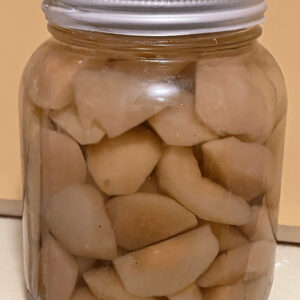
Reflections and Learnings
As we reflect on this journey, it becomes evident that the masting cycle has offered much more than a generous harvest. It has fostered a deeper connection with nature, encouraging us to observe closely and understand the rhythms that govern the natural world. The cycle has taught us to embrace the unexpected, to find joy in the bounty, and to navigate the challenges that come with it, transforming them into opportunities for learning and growth.
Through this journey, we have not only become adept at identifying the signs of a masting year but have also learned to prepare for the bounty that it brings, creating a space of creativity and joy in our kitchen, a place where memories are forged, and traditions are born.
The Impact of Masting on the Ecosystem
Biodiversity Benefits of the Masting Cycle
In a masting year, sometimes referred to as a mast fruiting period, the sudden influx of seeds and fruits in the ecosystem serves as a feast for a variety of wildlife. This abundance of food sources can significantly boost local biodiversity. Birds, rodents, and other small mammals find a rich feeding ground, encouraging a vibrant and diverse population of fauna in the affected regions.
Moreover, the masting cycle can influence the reproductive cycles of certain animal species, leading to an increase in their populations in the years following a mast year. This phenomenon, in turn, can have cascading effects on the predator-prey dynamics in the ecosystem, illustrating the deep interconnectedness of life forms in a habitat.
Enhancing Soil Health
The masting cycle plays a pivotal role in nurturing soil health. The fallen fruits and seeds, left to decompose, enrich the soil with organic matter and essential nutrients, fostering a fertile ground for other plants to thrive. This natural process of nutrient recycling is a cornerstone in ecological cycles, promoting soil fertility and reducing the dependency on synthetic fertilizers.
Furthermore, the decomposition process involves a host of microorganisms, including bacteria and fungi, which play a vital role in maintaining soil structure and health. These microorganisms help in breaking down organic matter into simpler compounds, making nutrients available to plants and thereby nurturing a rich, biodiverse soil ecosystem.
Challenges and Solutions in Agriculture
While the masting cycle is a natural phenomenon, it poses challenges in agricultural settings, particularly for farmers who rely on consistent yields year after year. The fluctuating production levels can affect economic stability and necessitate adaptive farming strategies to mitigate the impacts of low-yield years.
One approach to navigating this challenge is implementing agroforestry systems that incorporate a diversity of tree species with different masting cycles, ensuring a more stable production over the years. Moreover, understanding the triggers of masting can help in developing predictive models, allowing farmers to anticipate mast years and plan accordingly.
Climate Change and Masting
In recent years, researchers have been exploring the potential impact of climate change on masting cycles. Changes in temperature and precipitation patterns, along with extreme weather events, can potentially alter the masting rhythms of tree populations. Understanding the intricate relationship between climate variables and masting cycles is crucial in predicting future trends and adapting both conservation and agricultural practices to a changing climate.
Conservation and Restoration
Masting cycles hold significance in conservation and restoration efforts as well. The abundance of seeds in a mast year can be harnessed for reforestation projects, providing a rich seed source for establishing new plant populations. Moreover, understanding masting dynamics is vital in managing habitats for threatened and endangered species, helping to create environments that support the survival and growth of various species.
Masting Cycle: Lessons Learned
Embracing Nature’s Rhythms
Understanding the masting cycle, or synchronous seeding, teaches us to embrace the natural rhythms of the environment. It is a vivid demonstration of the ebbs and flows inherent in nature, where periods of abundance are followed by times of scarcity. This cycle encourages a perspective of patience and long-term planning, recognizing that fruitful periods will come, albeit interspersed with quieter years.
The Importance of Biodiversity
The masting cycle underscores the critical role of biodiversity in maintaining a balanced ecosystem. Through this phenomenon, we learn how a single species can influence a wide array of organisms, from the microorganisms in the soil to the larger animals that feed on the fruits. It is a lesson in interconnectedness, highlighting the delicate balance that sustains life in various habitats.
Sustainable Agriculture
For those involved in agriculture, the masting cycle offers insights into sustainable farming practices. It encourages the adoption of agroforestry systems and the diversification of crops to ensure stability in production over the years. Moreover, it promotes soil health through natural nutrient recycling processes, fostering a farming approach that works in harmony with nature rather than against it.
Climate Consciousness
As we delve deeper into the effects of climate change on natural phenomena, including masting cycles, we are encouraged to adopt a more climate-conscious approach to gardening and agriculture. Understanding the potential impacts of climate variables on masting rhythms can guide us in adapting our practices to mitigate adverse effects and foster resilience in our ecosystems.
Conservation and Restoration Efforts
The masting cycle holds valuable lessons for conservation and restoration efforts. It teaches us the importance of harnessing natural cycles in our efforts to restore degraded landscapes and conserve endangered species. By understanding the dynamics of masting, we can create environments that support the survival and growth of various species, playing a part in the larger goal of biodiversity conservation.
Personal Growth and Reflection
On a personal level, witnessing the masting cycle can be a source of reflection and growth. It encourages us to adopt a perspective of abundance, appreciating the bountiful years and learning to navigate the lean periods with grace and foresight. It is a journey of discovery, where each cycle brings new experiences and learnings, fostering a deeper connection with the natural world and enriching our understanding of the intricate web of life.
Conclusion
The Masting Cycle: A Tapestry of Life
As we navigate the intricate pathways of the masting cycle, we find ourselves immersed in a world of deep interconnectedness, where each element, from the smallest microorganism in the soil to the towering trees, plays a vital role in sustaining the delicate balance of the ecosystem. The masting cycle stands as a testament to the rich tapestry of life, woven with threads of abundance and scarcity, each playing a part in the grand design of nature.
Table: Key Takeaways from Our Journey
| Aspect | Insight |
|---|---|
| Biodiversity | Understanding the interconnected web of life |
| Sustainability | Learning sustainable practices from nature’s rhythms |
| Climate Impact | Adapting to the changing climate with informed practices |
| Personal Growth | Developing a deeper connection with the natural world |
As we close this chapter, we carry forward a rich repository of learnings, a deeper understanding of the world we inhabit, and a renewed sense of wonder and respect for the intricate dance of life that unfolds in our gardens and beyond. It is our hope that this exploration of the masting cycle has not only enriched your understanding but has also inspired a deeper connection with the natural world, encouraging a perspective of harmony and respect for the vibrant tapestry of life that surrounds us.
Continue Your Journey of Discovery with Our Comprehensive Guide
If you’ve been captivated by the masting cycle of pear trees and their impact on the ecosystem, you’ll find our Top 10 Berries and Fruits for Scandinavian Gardens: A Comprehensive Guide to be a natural extension of your interests.
This guide offers a deep dive into the world of fruits and berries that are well-suited for Scandinavian climates, providing you with a broader perspective on sustainable agriculture and ecosystem impact.
Why This Guide is a Must-Read:
- Ecosystem Dynamics: Learn about other fruits and berries that have a significant impact on local ecosystems, much like the masting cycle of pear trees.
- Sustainable Practices: Gain insights into eco-friendly cultivation methods that can enhance soil health and biodiversity.
- Personal Experiences: Read firsthand accounts of growing a variety of fruits and berries, adding depth to your understanding of their roles in the ecosystem.
Don’t miss the opportunity to expand your knowledge and deepen your connection with nature. Read the Comprehensive Guide Now.

